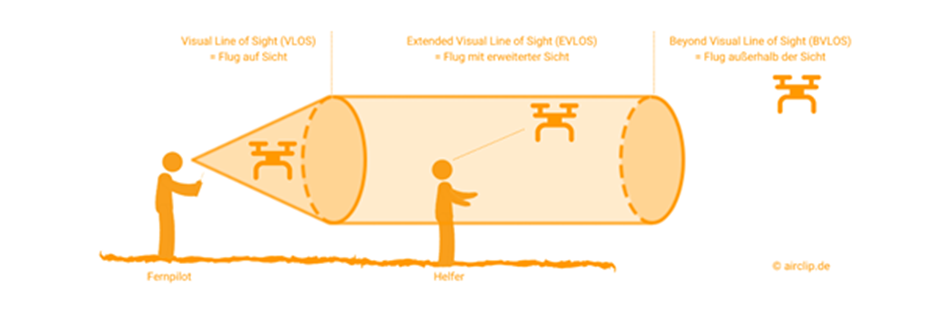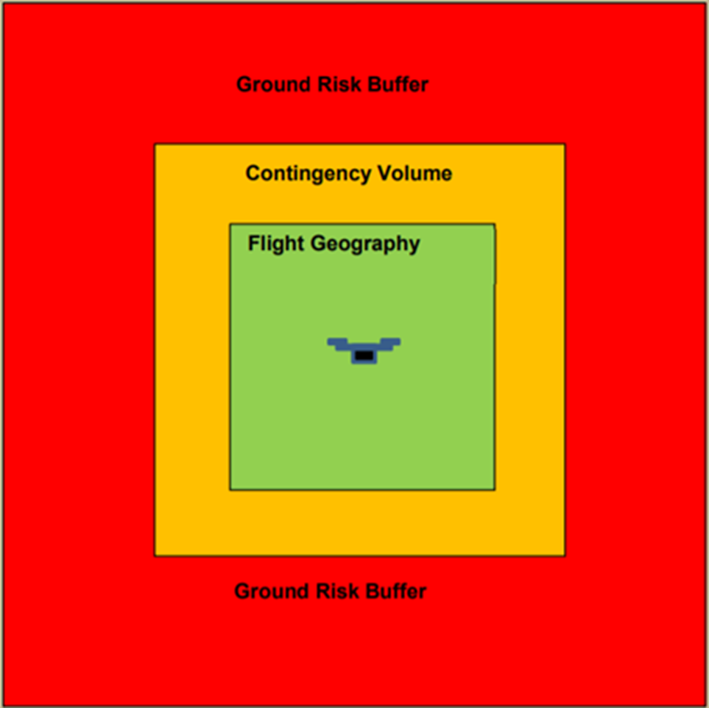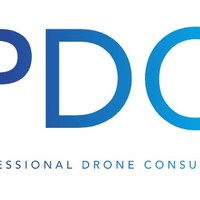Several relevant market researches point out the importance of BVLOS (Beyond Visual Line of Sight) operations, therefore the classification and risk assessment of these operations upon conditions clear and available for all UAS operators is of vital importance for the whole branch. The clarification of authorization of BVLOS drone flights helps the UAS operators to get complied with applicable rules on the one hand and – eventually – support the CAA (Civil Aviation Authority) in issuing more operational authorisations on the other hand, thereby contributing to the development of drone ecosystem.
The first step in this clarification process, to determine where the physical boundaries of BVLOS operations lie.
Due to Pre-defined Risk Assessments (PDRAs) issued by the European Union Aviation Safety Agency (EASA), the upper limit of VLOS (Visual Line of Sight) operations is 1 km. In case if the drone flies from the remote pilot further than this, the operation shall be - irrespective of every other aspect – considered as BVLOS operation.
This 1 km limit sounds quite precise for the first reading however, but this issue becomes more complex for the second one. Let’s see, why.
EVLOS
Even EASA admitted – indirectly – that defining the limit of VLOS/BVLOS was a difficult question. This can be derived from the fact, that it created – as a transitional solution – the so-called EVLOS (Extended Visual Line of Sight) as a third category between VLOS and BVLOS. In EVLOS, the remote pilot is assisted by a visual observer, who also follows the flight of the drone and is in constant radio connection with the remote pilot. With EVLOS the area of operation can be extended beyond the limits of VLOS (up to 2 km in general), but it requires at least two crewmembers, as figure 1. shows below.

Figure 1. the EVLOS (Source of the picture: link)
From technical aspect, it is clear what EVLOS means, but from legal point of view, it becomes problematic. EASA’s SORA risks assessment method – due to the latest version of its AMC – handles EVLOS operations as BVLOS from the aspect of ground risk classification, while STS-02 standard scenario also covers an EVLOS operation. This is important because the issue of an operational authorisation for BVLOS drone missions requires a lot more documents while in an EVLOS mission performed within the framework of STS-02 only a certain declaration from the UAS operator is expected – that is far easier than applying for operational authorisation.
In case of operations executed without visual observers, EASA leaves the UAS operators and CAAs alone in determining what the boundaries of VLOS operations are, and where the realm of BVLOS begins. Many of drones already available on the market are technically capable of exceeding the 1 km distance, but it can easily be understood at the same time, that human eyes can’t detect a simple camera drone from the same distance as they can a 70 kg spraying drone.
It can be seen that this general 1000 meter rule provides opportunity for illegal drone use and the German Federal Aviation Authority (LBA-Luftfahrt Bundesamt) has also realised this fact. Therefore, LBA has published a manual that explains how the VLOS and BVLOS operations shall be distinguished from each other.
ALOS and DLOS
Those who like English acronyms will so like the manual of LBA, because – as they say – the 1 km rule does not describe precisely the boundaries of VLOS operations and the concept of ALOS (Attitude Line of Sight) and DLOS (Detection Line of Sight) are far more apt to do so. LBA argues that these concepts can take the characteristics of human eyes and the differing sizes of drones into consideration.
ALOS indicates the distance from where the remote pilot can sense and determine the position and flight direction of the drones with his/her own eyes, while DLOS shows from how far the remote pilot can detect any other aerial vehicle without using any gadget.
Due to LBA’s explanation, the exact limit of VLOS shall be the lower value from ALOS or DLOS. Of course, if both values are higher than 1 km, the operation will be BVLOS. In the spirit of German precision, the LBA went further than simply creating “Greek sounding” acronyms and defined the maximum value of both ALOS and DLOS.
The formula of calculating these values is based on the characterizing dimension (CD) of the drone showing that the size of the drone does matter when the CAA decides whether an operation is VLOS or BVLOS. The table below show these values and methods of calculation.
|
ALOS Limit |
In case of rotorwing and multirotor drones |
ALOSmax = 372 * CD+20 meter |
|
In case of fixed wing drones |
ALOSmax = 490 * CD+30 meter |
|
|
DLOS Limit |
Max. 30 % of ground visibility. (It depends from the exact area and part of the day, but – due to LBA – gorund visibily may in no case exceed 5 km, which means 1,5 km is theoretical maximum value of DLOS. |
|
In case of a brand new DJI Mavic 3 the ALOS (according to its CD that the distance between the two most distant points thereof, i.e. the distance between the outer tips of opposite rotors) is 372*0,448+20 meters, that is approx. 186,7 meters. (This calculation shows that the original 1 km limit applies for at least 2,6 meter wide (or long) drones, for spraying drones for instance.)
As a basis for comparison: in case of the fixed wing Parrot Disco (its CD is the 115 cm wingspan) the ALOS limit shall be 593,5 meters.
The calculations will always be performed by LBA before issuing an operational authorisation or LUC and if the distance between the remote pilot (the little drone on the picture below) and the border of Contingency Volume and Ground Risk Buffer is greater than ALOS Limit or DLOS limit, the operation will be classified as BVLOS. (The green field sings the area where the drone shall fly according to the flight plan and that shall be not left by the drone unless something goes wrong.) The LBA’s document provides some allowance at the same time, because it can also be derived from the interpretation of the German CAA that the outer limit of Ground Risk Buffer is irrelevant when we have decide whether the operation is VLOS or not. This is important when the operation takes place over (even sparsely) populated areas, because this fact might impact on the ground risk class and the documentation requirements towards the UAS operator.

The picture is from LBA’s manual.
At the same time…
We don’t know from the manual why it uses the 372 and 490 as multiplier when computing ALOSmax values. The structure of fixed-wing aerial vehicles makes it easier to detect their flight direction from a greater distance and this can be a reason to their ALOS’s greater multiplier. Still this is not sufficient to explain why these exact multipliers where chosen and we do not know either what aspects or factors shall be considered when calculating DLOS values.
It is important to note that LBA’s document apply to Germany and has no general binding force towards CAAs of other EU Member States - like EASA’s AMC. Nevertheless, it is still worth considering what this manual includes and says. It calls attention to the fact that the circumstances of every drone operation are unique and so are the risks thereof. Moreover, the issuance of such “soft law” means like LBA’s manual means the biggest support –from the side of the state and CAAs – to the spread of specific category operations.

